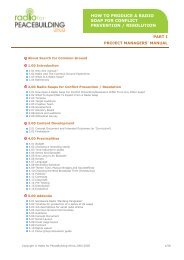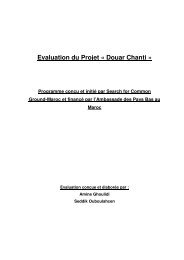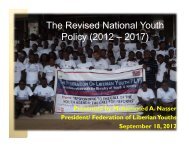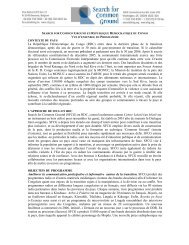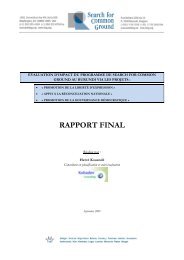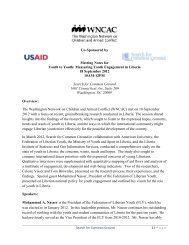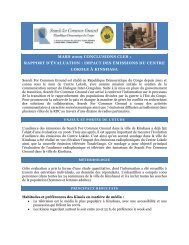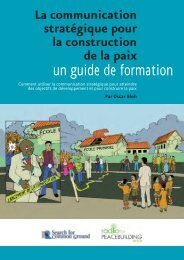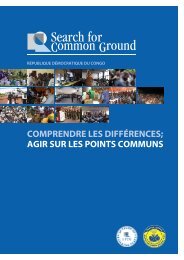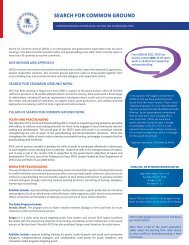What Are We Learning About Community-Based Child Protection ...
What Are We Learning About Community-Based Child Protection ...
What Are We Learning About Community-Based Child Protection ...
Create successful ePaper yourself
Turn your PDF publications into a flip-book with our unique Google optimized e-Paper software.
<strong>What</strong> <strong>Are</strong> <strong>We</strong> <strong>Learning</strong> <strong>About</strong> <strong>Community</strong>-<br />
<strong>Based</strong> <strong>Child</strong> <strong>Protection</strong> Mechanisms?<br />
Washington Network on<br />
<strong>Child</strong>ren and Armed Conflict<br />
December 10, 2009
Spirit of the Study<br />
• Urgent, systemic issues require systemic, large scale<br />
response using proven approaches<br />
• Paradigm shift—era of child protection systems<br />
• Important moment to reflect & take stock of what we are<br />
learning as a global child protection community<br />
• Emphasis on unanswered questions, key challenges and<br />
gaps, mutual learning<br />
• Beginning of a longer-term process<br />
of field learning and improving practice<br />
• Phase 2 research & field learning
Inter-Agency Team<br />
• Reference Group oversight<br />
- Displaced <strong>Child</strong>ren and Orphans Fund (DCOF), USAID<br />
- Oak Foundation<br />
- PULIH<br />
- International Save the <strong>Child</strong>ren Alliance;<br />
- UNICEF ESARO, WCARO, HQ<br />
- World Vision<br />
• Save the <strong>Child</strong>ren UK management<br />
• Consultant team
Rationale for <strong>Community</strong>-<strong>Based</strong><br />
<strong>Child</strong> <strong>Protection</strong> Mechanisms<br />
• Widespread child protection issues in<br />
emergency, transition, and development<br />
contexts<br />
• Inability or unwillingness of governments<br />
to protect children<br />
• Low cost means of supporting large numbers of children<br />
• Engaging community resources, values, and supports<br />
• Key element in national child protection systems<br />
• Developing contextually appropriate, sustainable supports
Why This Review?<br />
• <strong>Child</strong> <strong>Protection</strong> Committees as a ‘reflex’<br />
• Lack of a strong evidence base—which approaches are<br />
most effective, how can we achieve sustainable results,<br />
what are the unintended consequences of CPCs?<br />
• Strong evidence is needed to:<br />
- improve the quality of practice<br />
- raise appropriate levels of funding<br />
- influence policy leaders
Objectives<br />
• Provide a broad mapping of scale and coverage of<br />
community-based child protection groups…<br />
• Document common models and approaches..<br />
• Document common roles, responsibilities and key<br />
activities of community groups; Assess the strength and<br />
quality of the evidence base…<br />
• Synthesize the available global evidence on the impact<br />
and effectiveness of community based child protection<br />
groups…<br />
• Provide a broad review of lessons on community<br />
mobilization which can be drawn from other sectors, in<br />
particular health and HIV and AIDS<br />
• Inform the second phase field-based research…
Methodology<br />
• Document collection—Reference Group and outreach to<br />
diverse agencies, regions<br />
• Selection of documents—inclusion criteria & broad<br />
approach<br />
- groups at community & district level--not national level<br />
- groups focused on children’s protection issues<br />
- groups whose role consists of caring for and protecting<br />
children, and supporting broader well-being outcomes<br />
for children—includes muti-purpose groups<br />
- community-based child protection approaches that<br />
involve 1 or 2 community volunteers (e.g., GBV focal<br />
points)..<br />
• Search of social science literature via EBSCO data base
The Document Set<br />
• 265 candidate documents were received—95% in English<br />
• 105 did not meet inclusion criteria<br />
• 160 documents were reviewed<br />
• Desk review of 160 documents worldwide<br />
- primary review set: 130 grey literature<br />
evaluations—emergency, transition,<br />
development (English (117), Spanish (8),<br />
French (5))<br />
- 26 published social science papers<br />
- 4 reviews from the health sector
Percent of Documents by Region
Percent of Documents by Technical Focus
Percentage of Documents by Context
Document Review<br />
• Matrix summary & analysis<br />
- document description<br />
- description & analysis of community-based child<br />
protection group (formation process, selection,<br />
functions/roles, resourcing, linkages)<br />
- evaluation methodology<br />
- key findings/lessons<br />
- comments<br />
• Cross-checking, reflection, dialogue, and<br />
revision if needed
Typology of <strong>Community</strong> Engagement<br />
Approaches<br />
• Category 1: Direct implementation by agency: The agency is a service<br />
provider; community members are beneficiaries.<br />
• Category 2: <strong>Community</strong> involvement in agency initiative: The agency<br />
is a promoter of its own initiative, a planner and a trainer, and<br />
community members are volunteers and beneficiaries.<br />
• Category 3: <strong>Community</strong> owned and managed activities mobilized by<br />
external agency: The agency is a catalyst, capacity builder, a facilitator<br />
of linkages, and a funder after community ownership has developed.<br />
The community members are analysts, planners, implementers,<br />
assessors, and also beneficiaries.<br />
• Category 4: <strong>Community</strong> owned and managed activities initiated from<br />
within the community: The agency is a capacity builder and funder,<br />
and community members are analysts, planners, implementers,<br />
assessors, and also beneficiaries.
Analysis and Synthesis<br />
• Plans for meta-analysis were infeasible<br />
• Inductive approach—identification of recurrent themes,<br />
areas of convergence and divergence<br />
• Development and ‘mining’ of working hypotheses (e.g.,<br />
‘<strong>Community</strong> owned action to support vulnerable children<br />
is more likely to be sustainable than actions directed and<br />
conducted by outside agencies.’)<br />
• Attention to possible biases—reflection, dialogue and<br />
cross-checking
Development of Suggestions for<br />
Phase 2<br />
• Identification of key issues, gaps, questions<br />
• Scanning for programs and contexts that are<br />
‘ripe’ for further learning/research<br />
• Telephone follow-up discussions with<br />
selection programs<br />
• Not comprehensive—additional inputs from<br />
Reference Group and Nairobi meeting
Limitations<br />
• Difficult to draw firm conclusions about causation in fluid<br />
contexts with many political and economic changes<br />
• Emphasis on externally initiated or supported groups<br />
• Difficult to isolate the specific effects of a communitybased<br />
child protection group<br />
• Geography and language gap—limited input from Latin<br />
America<br />
• Limited time frame<br />
• Challenges of definition—what is ‘community’, ‘child<br />
protection’, ‘formal protection system’?<br />
• Yet a group of useful findings emerged consistently across<br />
agencies, regions, evaluators<br />
• Key lessons are provisional yet include:
Key Findings—Summary<br />
• The base of evidence in this field is very weak.<br />
• <strong>Child</strong> focused groups are a highly diverse, adaptable,<br />
scalable, and replicable approach to child protection in<br />
different contexts.<br />
• When implemented well, child focused groups are<br />
effective means of protecting children.<br />
• Sustainability is a significant challenge<br />
and depends primarily on the level of<br />
community ownership of and<br />
responsibility for child focused groups.
Key Finding 1:<br />
A Very <strong>We</strong>ak Evidence Base<br />
• Most evaluations included no baseline measurements.<br />
• Measures of actual outcomes for children were rare.<br />
• Few measures of household and family well-being were<br />
used.<br />
• Quantitative data were typically for output or process<br />
indicators.<br />
• Qualitative data were typically collected on convenience<br />
samples.<br />
• Methods of analyzing data were seldom described.<br />
• Many of the interviews and focus group discussions that<br />
comprised the bulk of the evidence were subject to<br />
numerous biases which evaluators seldom mentioned.
Percentage of Papers by Evaluation Method
2. Forms and Functions<br />
• Composition<br />
- 10-20 participants, usually community selected men and<br />
women<br />
- some included children, particularly teenagers<br />
- diversity & representation of different sub-groups<br />
• <strong>Child</strong> Rights Committees vs. <strong>Child</strong> <strong>Protection</strong> Committees<br />
- broader rights vs. protection rights<br />
- different emphases on monitoring, reporting, & advocacy<br />
vs. direct response (mediation, problem-solving, support<br />
for survivors, development of local solutions)<br />
• Broad spectrum groups: addressed a wide array of child<br />
protection and well-being issues<br />
• Focused groups: organized around particular issue or set of<br />
issues such as trafficking, labor, HIV and AIDS
3. Seven Factors Contributed to the<br />
Effectiveness and Sustainability of<br />
<strong>Community</strong>-<strong>Based</strong> <strong>Child</strong> Focused Groups<br />
• <strong>Community</strong> ownership and responsibility<br />
• Incorporating and building on existing resources<br />
• Leaders’ support<br />
• Genuine child participation<br />
• Ongoing management of issues of power, diversity,<br />
inclusivity<br />
• Resourcing—ongoing training/capacity building, material<br />
support<br />
• Linkages—engagement with formal and nonformal,<br />
traditional systems
4. Determinants of Ownership—<br />
Approach to <strong>Community</strong> Engagement
Factors That Promote or Limit<br />
<strong>Community</strong> Ownership<br />
• Promote<br />
- A sense of collective<br />
responsibility<br />
- Patient cultivation<br />
- Skill in facilitation<br />
- Identity<br />
- Mobilization of community<br />
resources<br />
• Limit<br />
- Early introduction of large<br />
sums of money<br />
- Agency oriented<br />
engagement with<br />
community<br />
- Didactic, top-down<br />
approaches<br />
- Failure to build on local<br />
ideas and resources
5.Tradeoff Between Level of Ownership<br />
and Scope of <strong>Child</strong> <strong>Protection</strong> Work<br />
• <strong>Community</strong> owned approaches did not address the most<br />
difficult, sensitive issues such as GBV and family violence<br />
• Virtually all of the broad spectrum<br />
groups had a Category 2 approach<br />
to community engagement.<br />
• Some evidence suggested that groups<br />
that had begun with a focused<br />
approach could expand their scope<br />
of work over time.
Additional Key Findings<br />
• Levels of child participation were low to moderate, yet child<br />
perspectives and creativity contributed to effectiveness<br />
• Too little is done typically to manage issues of power, diversity, and<br />
inclusivity<br />
• <strong>Child</strong> rights are often introduced to communities using a top-down,<br />
didactic approach that is ineffective and elicits backlash<br />
• Ongoing capacity building is an issue—too little follow-up and<br />
mentoring after initial training(s)<br />
• The evidence regarding the use of stipends is mixed and highly<br />
contextual<br />
• Effective linkage of community-based groups with formal systems of<br />
child protection boosts the effectiveness and scale of response yet may<br />
reduce the sense of community ownership<br />
• In many contexts, child focused groups begun during emergencies do<br />
not continue into the early recovery and development phases, nor do<br />
the outcomes achieved continue beyond the end of the funded period
• Gender-based violence<br />
• Family violence<br />
Gaps<br />
• <strong>Protection</strong> of very young children<br />
• Psychosocial support<br />
• Working to change attitudes and practices on<br />
sensitive issues through a slow process of<br />
dialogue, problem-solving, and internally guided<br />
change
• Confidentiality<br />
• Raised expectations<br />
Do No Harm Issues<br />
• Restricting children’s freedom of movement<br />
• Excessive targeting—jealousies<br />
• Perverse incentives<br />
• Patronage and reinforcement of local power<br />
structures<br />
• Imposition of outsider approaches<br />
• Creation of parallel systems<br />
• Duplication, marginalization, and undermining of existing<br />
supports<br />
• Failure to feed information back to communities
Challenges<br />
• Make it a social norm to conduct regular, systematic<br />
evaluations and use the results to strengthen practice<br />
• Enable child-focused groups to fulfill appropriate roles and<br />
responsibilities<br />
• Produce sustainable, positive outcomes on a broad<br />
spectrum of child protection issues<br />
• Take a dialogue oriented, respectful approach to child<br />
protection at community level<br />
• Facilitate community ownership of child-focused groups<br />
even in emergencies<br />
• Change donor practices in regard to the duration, amount,<br />
structure, and orientation of funding for child focused<br />
groups
Implications for Phase 2<br />
• How can we begin building community ownership and<br />
sustainability even during emergencies?<br />
• How can we build synergies between community-based<br />
groups and national child protection systems?<br />
• <strong>What</strong> measures of child, family, and community outcomes<br />
are most appropriate—how can we raise the standard of<br />
evidence?<br />
• <strong>What</strong> practices, mechanisms, resources, etc. do<br />
communities have that support children’s protection and<br />
well-being and how can programs build more effectively<br />
on these?<br />
• How can we address effectively the most sensitive child<br />
protection issues, even during emergencies?<br />
• How can we collaborate to strengthen child protection at<br />
all levels?



